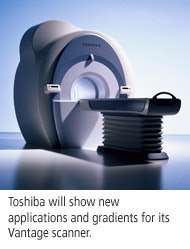Toshiba will highlight the 64-slice version of its Aquilion CT platform, and the first commercial shipments of the 64-slice model started in October. The Tustin, CA, company will demonstrate both radiology and cardiology versions of Aquilion, and will also showcase a new wide-bore CT scanner designed for radiation therapy planning applications.
Toshiba introduced the 64-slice Aquilion 64 at the International Symposium on Multidetector-Row CT meeting in San Francisco in June, and a month later announced the development of Aquilion 64 CFX, a system optimized for imaging the coronary arteries.

The Aquilion 64 platform is based on a 64-row Quantum detector and features spatial resolution of 0.35 mm. The scanner collects data in isotropic voxels, meaning that axial, coronal, and sagittal sections have the same spatial resolution. Toshiba believes that this reduces artifacts caused by partial-volume averaging when voxels of different dimensions are used.
Aquilion 64 has a 1.8-m patient couch with 32 mm of total detector coverage per rotation and is capable of 64 x 0.5 mm acquisitions. Gantry rotation speeds as fast as 0.4 seconds are possible, according to the company.
Aquilion 64 CFX features a similar architecture, and includes software packages designed to support automated diagnostic cardiac studies. Applications include cardiac scoring, cardiac angiography, advanced cardiac analysis, trauma, CT fluoroscopy, CT angiography and run-offs, pediatrics, and high-resolution lung scanning.
Toshiba also sells a 32-slice version of Aquilion, which was first launched at the 2003 RSNA meeting. Like the 64-slice scanners, Aquilion 32 employs 0.35-mm isotropic scanning, 32 mm of detector coverage, and a 400-msec gantry-rotation speed. The scanner conducts acquisitions at 32 x 0.5 mm and 32 x 1 mm, and is also available in a CFX option. The Aquilion line also comes in 16-slice, 8-slice, and 4-slice versions.
In radiation oncology, Aquilion LB is a new wide-bore scanner that marks Toshiba's entry into the market for CT systems optimized for radiation therapy planning studies. The system is based on a 16-slice Aquilion platform with a 90-cm gantry bore.
Toshiba believes that Aquilion LB's wide bore makes the system particularly useful for certain types of radiation therapy planning procedures that aren't possible on dedicated oncology CT scanners from other vendors. The 90-cm bore, for example, makes it possible for breast cancer patients to hold their arms above their bodies during treatment planning, a position that matches that used during treatment in a linear accelerator radiation therapy system, according to the company.
The scanner does not yet have FDA clearance and will be shown as a work-in-progress at the RSNA meeting. Commercial shipments are expected in June 2005.
By Brian Casey
AuntMinnie.com staff writer
November 9, 2004
Copyright © 2004 AuntMinnie.com




















